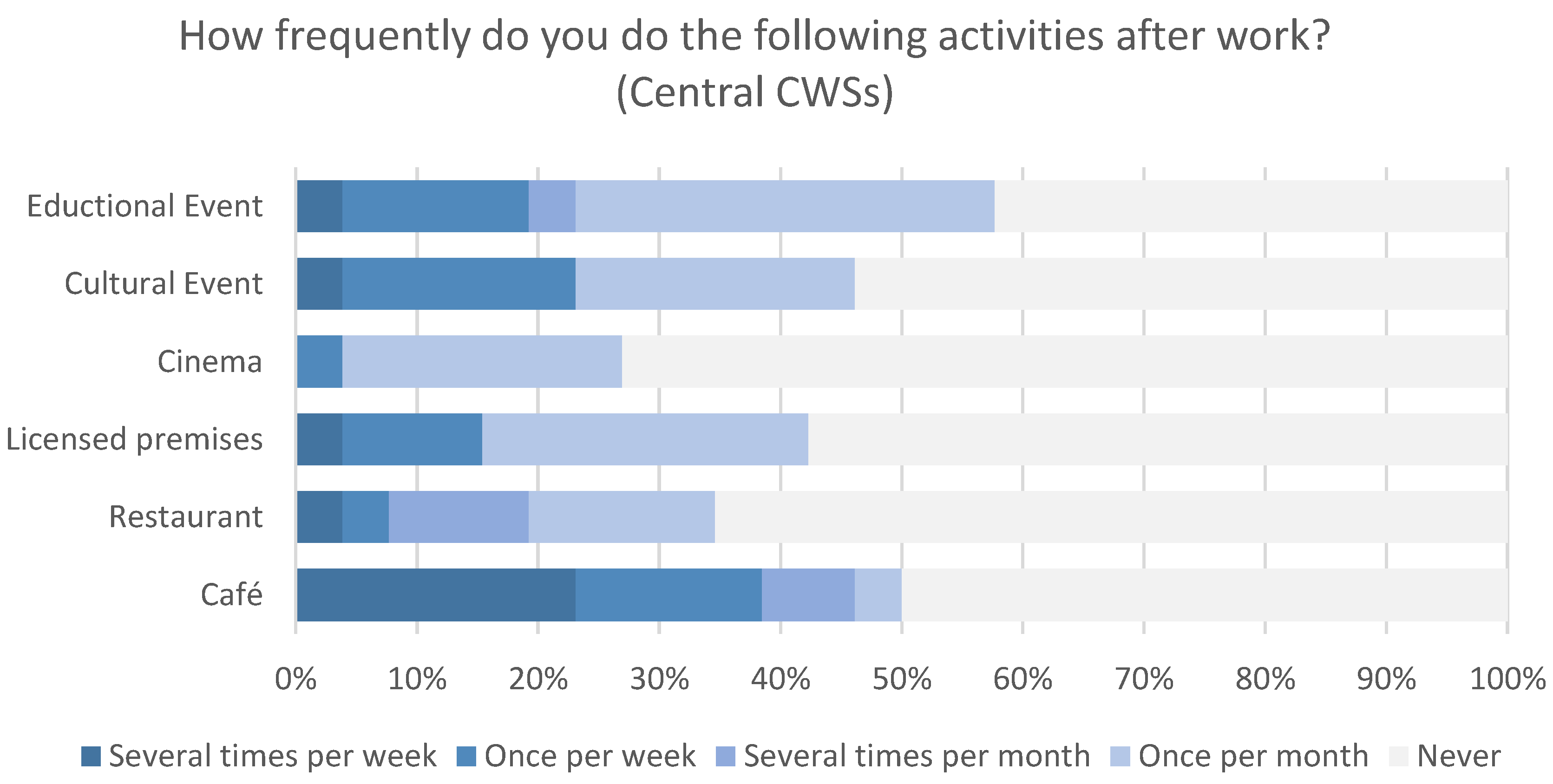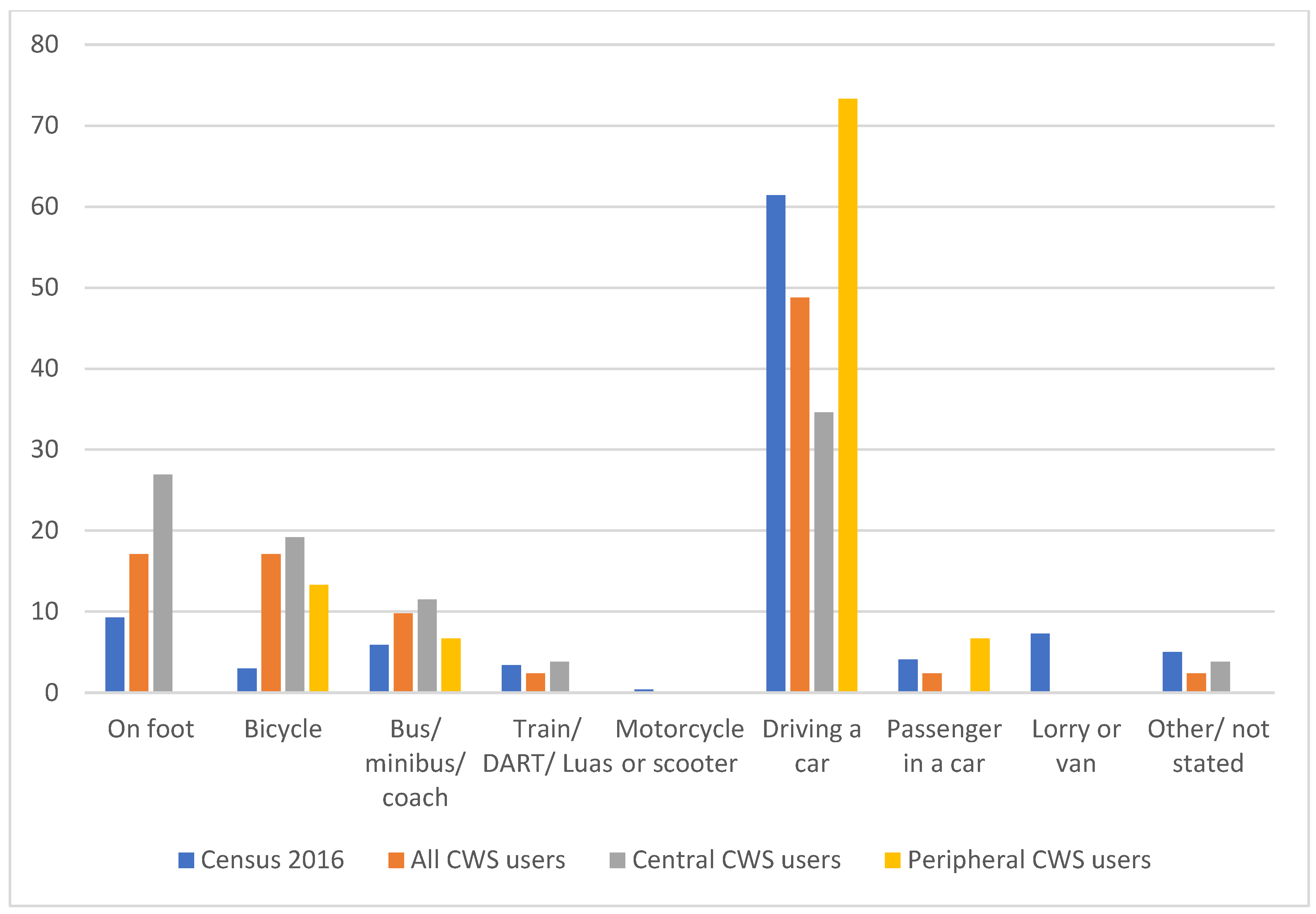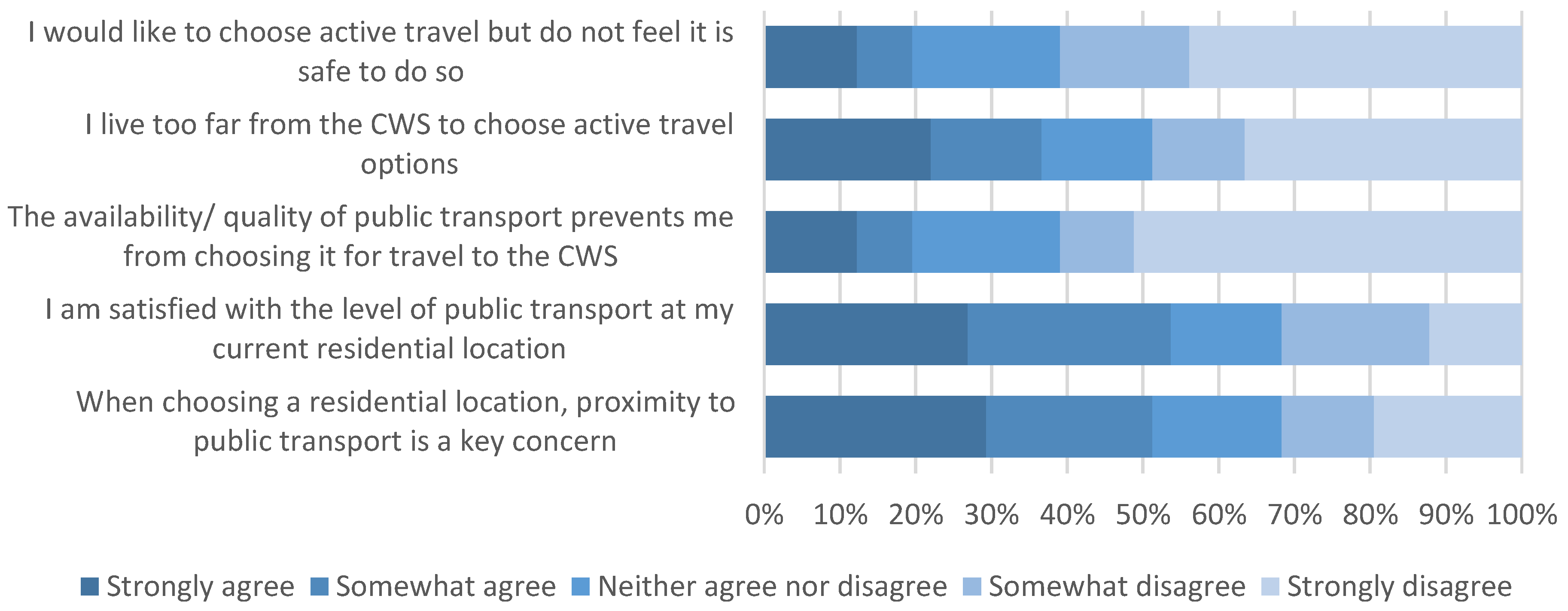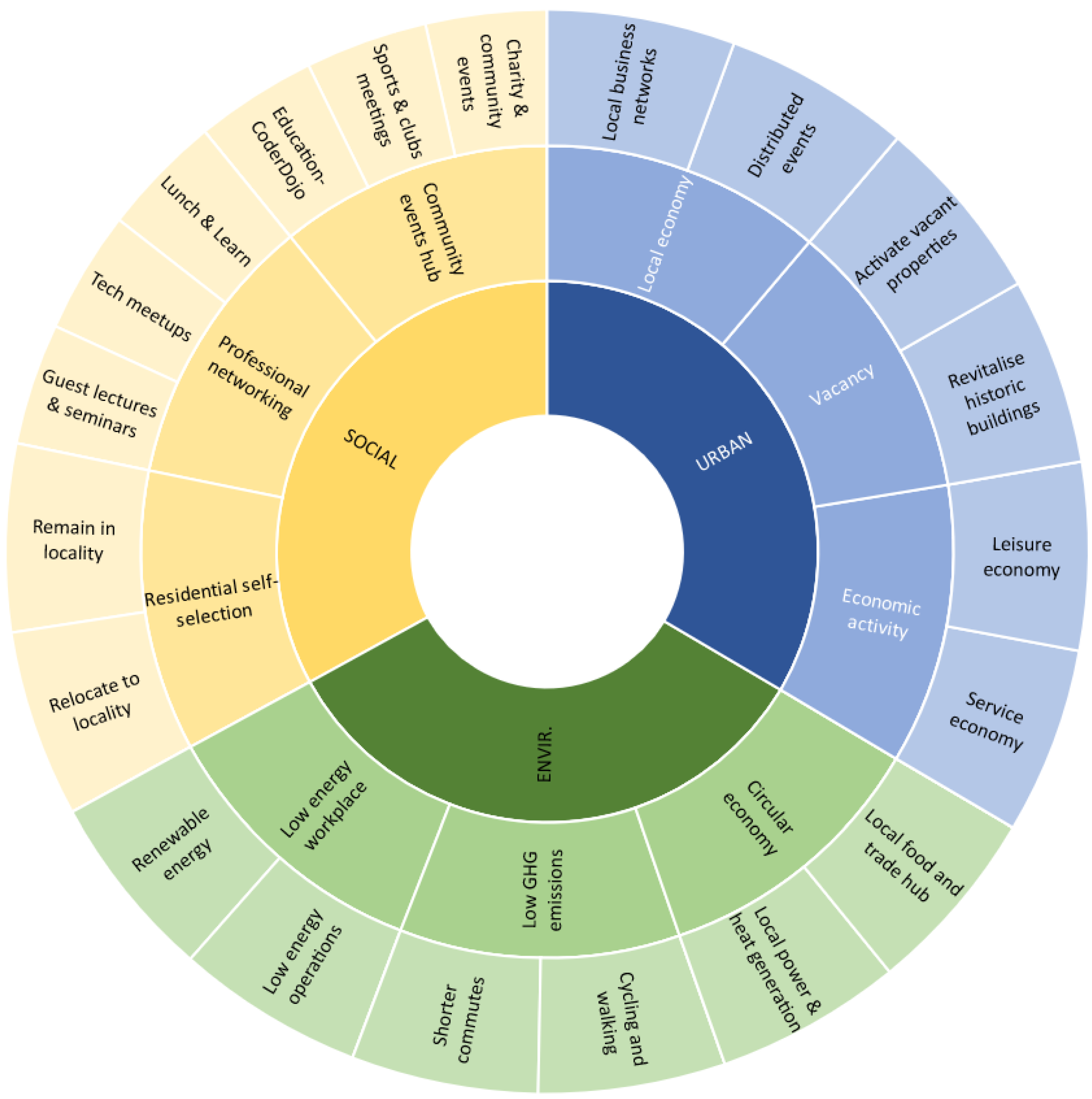Identifying the Social, Urban, and Environmental Co-Benefits of Coworking Spaces in Irish Towns
Abstract
:1. Introduction
2. Literature Review
2.1. Social Impacts: Residential Self-Selection and Addressing Population Decline
2.2. Urban Impacts: Local, After-Hours, and Culture-Led Economies
2.3. Environmental Impacts: Commuting and Operational Energy
3. Materials and Methods
4. Results
4.1. Survey
4.1.1. Social Impacts: Activities and Residential Location
4.1.2. Urban Impacts: Supporting Local Economies
4.1.3. Environmental Impacts: Commuting and Active Travel
4.2. Semi-Structured Interviews
4.2.1. Interview Results: Motivation and Outcomes
Motivation
Outcomes
4.2.2. Location and Origin of Premises
4.2.3. Social, Urban, and Environmental Impacts
Social
Urban
Environmental
5. Discussion
5.1. Social Co-Benefits of CWSs
5.2. Urban Co-Benefits of CWSs
5.3. Environmental Co-Benefits of CWSs
5.4. Government-Level Policy Implications
5.5. Limitations and Further Research
6. Conclusions
Author Contributions
Funding
Institutional Review Board Statement
Informed Consent Statement
Data Availability Statement
Conflicts of Interest
References
- Irish Government. Remote Work in Ireland: Future Jobs 2019; Government Publications Office: Dublin, Ireland, 2019. [Google Scholar]
- Yu, R.; Burke, M.; Raad, N. Exploring impact of future flexible working model evolution on urban environment, economy and planning. J. Urban Manag. 2019, 8, 447–457. [Google Scholar] [CrossRef]
- Irish Government. Available online: https://connectedhubs.ie/ (accessed on 18 June 2021).
- IPCC. Co-Benefits and Links to Sustainable Development. Available online: https://archive.ipcc.ch/publications_and_data/ar4/wg3/en/tssts-ts-6-5-co-benefits-and.html (accessed on 24 October 2023).
- Hook, A.; Court, V.; Sovacool, B.K.; Sorrell, S. A systematic review of the energy and climate impacts of teleworking. Environ. Res. Lett. 2020, 15, 93003. [Google Scholar] [CrossRef]
- Leonardi, P.M. COVID-19 and the New Technologies of Organizing: Digital Exhaust, Digital Footprints, and Artificial Intelligence in the Wake of Remote Work. J. Manag. Stud. 2021, 58, 247–251. [Google Scholar] [CrossRef]
- Spinuzzi, C. Working Alone Together: Coworking as Emergent Collaborative Activity. J. Bus. Tech. Commun. 2012, 26, 399–441. [Google Scholar] [CrossRef]
- Henderson, D.K.; Mokhtarian, P.L. Impacts of center-based telecommuting on travel and emissions: Analysis of the Puget Sound Demonstration Project. Transp. Res. Part D Transp. Environ. 1996, 1, 29–45. [Google Scholar] [CrossRef]
- Zenkteler, M.; Darchen, S.; Mateo-Babiano, I.; Baffour, B. Home-based work in cities: In search of an appropriate urban planning response. Futures J. Policy Plan. Futures Stud. 2022, 135, 102494. [Google Scholar] [CrossRef]
- Houghton, K.R.; Foth, M.; Hearn, G. Working from the other office: Trialling co-working spaces for public servants. Aust. J. Public Adm. 2018, 77, 757–778. [Google Scholar] [CrossRef]
- Berbegal-Mirabent, J. What Do We Know about Co-Working Spaces? Trends and Challenges Ahead. Sustainability 2021, 13, 1416. [Google Scholar] [CrossRef]
- Mariotti, I.; Pacchi, C.; Di Vita, S. Co-working Spaces in Milan: Location Patterns and Urban Effects. J. Urban Technol. 2017, 24, 47–66. [Google Scholar] [CrossRef]
- Orel, M.; Bennis, W.M. Classifying changes. A taxonomy of contemporary coworking spaces. J. Corp. Real Estate 2021, 23, 278–296. [Google Scholar] [CrossRef]
- Motamed, B.; Shirvanimoghaddam, K. The Local Co-Working Hub: A Merging Solution. Urban Sci. 2021, 5, 15. [Google Scholar] [CrossRef]
- De Peuter, G.; Cohen, N.S.; Saraco, F. The ambivalence of coworking: On the politics of an emerging work practice. Eur. J. Cult. Stud. 2017, 20, 687–706. [Google Scholar] [CrossRef]
- Bhattacharyya, S.S.; Nair, S. Explicating the future of work: Perspectives from India. J. Manag. Dev. 2019, 38, 175–194. [Google Scholar] [CrossRef]
- Tintiangko, J.; Soriano, C.R. Coworking spaces in the global south: Local articulations and imaginaries. J. Urban Technol. 2020, 27, 67–85. [Google Scholar] [CrossRef]
- Irish Government. Making Remote Work: National Remote Work Strategy; Department of Enterprise, Trade and Employment, Ed.; Government of Ireland: Dublin, Ireland, 2021. [Google Scholar]
- Irish Government. Town Centre First: A Policy Approach for Irish Towns; Government of Ireland: Dublin, Ireland, 2022. [Google Scholar]
- Irish Government. Our Rural Future: Rural Development Policy 2021–2025; Government of Ireland: Dublin, Ireland, 2021. [Google Scholar]
- Akhavan, M. Third Places for Work: A Multidisciplinary Review of the Literature on Coworking Spaces and Maker Spaces. In New Workplaces—Location Patterns, Urban Effects and Development Trajectories; Springer International Publishing: Cham, Switzerland, 2021; pp. 13–32. [Google Scholar] [CrossRef]
- Luo, Y.; Chan, R. Production of coworking spaces: Evidence from Shenzhen, China. Geoforum 2020, 110, 97–105. [Google Scholar] [CrossRef]
- Cao, J. Residential self-selection in the relationships between the built environment and travel behavior. J. Transp. Land Use 2014, 7, 1–3. [Google Scholar] [CrossRef]
- Cao, J.; Ettema, D. Satisfaction with travel and residential self-selection: How do preferences moderate the impact of the Hiawatha Light Rail Transit line? J. Transp. Land Use 2014, 7, 93–108. [Google Scholar] [CrossRef]
- Buchnik, T.; Frenkel, A. The lifestyles of millennial coworkers in urban spaces: The case of Tel-Aviv. Eur. Plan. Stud. 2023, 31, 528–553. [Google Scholar] [CrossRef]
- Tomaz, E.; Moriset, B.; Teller, J. Rural coworking spaces in the COVID-19 era: A window of opportunity? In The COVID-19 Pandemic and the Future of Working Spaces; Routledge: London, UK, 2022; pp. 122–135. [Google Scholar]
- Mariotti, I.; Capdevila, I.; Lange, B. Flexible Geographies of New Working Spaces; Taylor & Francis: Abingdon, UK, 2023; pp. 1–12. [Google Scholar]
- Bilandzic, M.; Foth, M. Libraries as coworking spaces: Understanding user motivations and perceived barriers to social learning. Libr. Hi Tech 2013, 31, 254–273. [Google Scholar] [CrossRef]
- Buksh, B.; Mouat, C.M. Activating smart work hubs for urban revitalisation: Evidence and implications of digital urbanism for planning and policy from South-East Queensland. Aust. Plan. 2015, 52, 16–26. [Google Scholar] [CrossRef]
- Jamal, A.C. Coworking spaces in mid-sized cities: A partner in downtown economic development. Environ. Plan. A 2018, 50, 773–788. [Google Scholar] [CrossRef]
- Hölzel, M.; de Vries, W.T. Digitization as a driver fur rural development—An indicative description of German coworking space users. Land 2021, 10, 326. [Google Scholar] [CrossRef]
- Bacevice, P. The consumerization of work in the modern city: Storefronts, coworking, and the convergence of production and consumption. Built Environ. 2022, 48, 104–122. [Google Scholar] [CrossRef]
- El Sahli, L.; Akhavan, M.; Kassem, A. A look into Beirut’s coworking scene. Exploring the pre-and post-pandemic conditions. In The COVID-19 Pandemic and the Future of Working Spaces; Routledge: London, UK, 2022; pp. 52–65. [Google Scholar]
- Bednář, P.; Danko, L. Coworking Spaces as a Driver of the Post-Fordist City: A Tool for Building a Creative Ecosystem. Eur. Spat. Res. Policy 2020, 27, 105–125. [Google Scholar] [CrossRef]
- Ohnmacht, T.; Z'Rotz, J.; Dang, L. Relationships between coworking spaces and CO2 emissions in work-related commuting: First empirical insights for the case of Switzerland with regard to urban-rural differences. Environ. Res. Commun. 2020, 2, 125004. [Google Scholar] [CrossRef]
- Vaddadi, B.; Ringenson, T.; Sjöman, M.; Hesselgren, M.; Kramers, A. Do they work? Exploring possible potentials of neighbourhood Telecommuting centres in supporting sustainable travel. Travel Behav. Soc. 2022, 29, 34–41. [Google Scholar] [CrossRef]
- Bieser, J.C.T.; Vaddadi, B.; Kramers, A.; Höjer, M.; Hilty, L.M. Impacts of telecommuting on time use and travel: A case study of a neighborhood telecommuting center in Stockholm. Travel Behav. Soc. 2021, 23, 157–165. [Google Scholar] [CrossRef]
- Souche-Le Corvec, S. Which transport modes do people use to travel to coworking spaces (CWSs)? Multimodal Transp. 2023, 2, 100078. [Google Scholar] [CrossRef]
- Kelly, J.A.; Kelleher, L.; Guo, Y.; Deegan, C.; Larsen, B.; Shukla, S.; Collins, A. Assessing preference and potential for working from anywhere: A spatial index for Ireland. Environ. Sustain. Indic. 2022, 15, 100190. [Google Scholar] [CrossRef]
- Vaddadi, B.; Bieser, J.; Pohl, J.; Kramers, A. Towards a conceptual framework of direct and indirect environmental effects of co-working. In Proceedings of the 7th International Conference on ICT for Sustainability, Bristol, UK, 21–26 June 2020; pp. 27–35. [Google Scholar]
- Coworking. Coworking in Ireland. Available online: https://www.coworking.ie/ (accessed on 22 June 2021).
- CSO. Census of Population 2016-Profile 6 Commuting in Ireland. Available online: https://www.cso.ie/en/releasesandpublications/ep/p-cp6ci/p6cii/p6mtw/ (accessed on 21 August 2021).
- McCafferty, D. Fifty years of urbanisation in Ireland: Structural and spatial evolution of the urban hierarchy since Buchanan. Administration 2019, 67, 65–89. [Google Scholar] [CrossRef]
- Crowe, P.; Lyes, M.; Murphy, O. The Town Centre Living Initiative: Synthesis Report; Space Engagers: Dublin, Ireland, 2020. [Google Scholar]





| Variable | Response | No. (%) |
|---|---|---|
| Gender | Female | 13 (31.7) |
| Male | 28 (68.3) | |
| Other/not stated | 0 (0) | |
| Age | 18–30 | 12 (29.3) |
| 31–40 | 11 (26.8) | |
| 41–50 | 9 (22) | |
| 51–60 | 6 (14.6) | |
| 61–70 | 3 (7.3) | |
| Nationality | Irish | 35 (85.4) |
| Non-Irish EU citizen | 5 (12.2) | |
| Non-EU citizen | 1 (2.4) |
| Question/Topic | Sample Responses (Quotes) |
|---|---|
| If you have any comments on public transport availability at your home and/or CWS, please give details. |
|
| If you have any comments on active travel to/from your CWS, please give details. |
|
| Variable | Detail | No. (%) |
|---|---|---|
| Gender | Female | 3 (18.75) |
| Male | 13 (81.25) | |
| Position | Founder | 9 (56.25) |
| Manager * | 4 (25) | |
| Coordinator ** | 3 (18.75) | |
| Category of CWS | Private | 9 (56.25) |
| Public—standalone CWS | 2 (12.5) | |
| Public—enterprise centre | 5 (31.25) | |
| Location of CWS *** | Village (<1.5k pop) | 3 (18.75) |
| Small town (1.5–5k pop) | 7 (43.75) | |
| Medium town (5–10k pop) | 1 (6.25) | |
| Large town (10–50k pop) | 3 (18.75) | |
| City (50k+) | 2 (12.5) |
| Main Question | Key Themes and No. (%) Responses | Examples (Quotes) |
|---|---|---|
| What was the main original purpose/motivation for establishing the CWS? | Community/public initiative: 7 (43.75) Private enterprise: 9 (56.25) |
|
| How was the CWS building/premises chosen? | Building was in the ownership of operator: 5 (31.25) Building was available to buy: 2 (12.5) Building was available to rent: 6 (37.5) Building was purpose-built: 3 (18.75) |
|
| What range of services/facilities does the CWS provide? | Open plan CWS: 16 (100) Private offices: 11 (68.75) Podcast/broadcast studio: 3 (18.75) |
|
| Has the CWS received any public funding? | In receipt of public funding at foundation/at foundation and thereafter: 7 (43.75) In receipt of public funding since foundation: 7 (43.75) No public funding: 2 (12.5) |
|
| Does the CWS facilitate active travel for co-workers? | Facilities (bicycle parking and/or shower facilities) available on-site: 4 (25) Facilities on-site in planning/development: 2 (12.5) Facilities locally: 5 (31.25) No active travel facilities: 5 (31.25) |
|
| Does the CWS have strategies for reducing operational energy use? | Low-energy strategy in operation: 6 (37.5) Low-energy strategy in development: 5 (31.25) No low-energy strategy: 5 (31.25) |
|
| Is the CWS available for community uses/events? | Yes, free, or nominal fee, for community events: 11 (68.75) Yes, mostly revenue-raising: 4 (25) No: 1 (6.25) |
|
| Networking | Cultural | Community | Sport | Other |
|---|---|---|---|---|
| Founders Friday | Art exhibitions | Christmas fair | Sports clubs’ AGM | Charity coffee mornings |
| Lunch & learn | Guest lectures | Political Q&A | Slimming World | CoderDojo |
| Tech meetup | Music gigs | Community education | Sports clubs’ meetings | Student study sessions |
| Tax advice clinic | Arts & literature festivals | Counselling services | Yoga classes | Chamber of Commerce |
| Category | Co-Benefit |
|---|---|
| Social | CWS as a hub for community events |
| CWSs facilitate on-site cultural, community, and educational events for the public and users of CWSs. Operators use this as a revenue-raising and/or promotional strategy. | |
| CWS as a generator of collaborations and networking | |
| The interior layout of the CWS can encourage chance encounters and social interaction of users in a convivial setting. Some CWSs assign a user or employ a person to be a “catalyst” to coordinate suitable events, such as Pecha Kucha evenings. | |
| CWS as reinforcer of rural/small town populations | |
| The presence of a CWS allows users to remain in a locality/relocate to a locality that would otherwise be unfeasible. | |
| Urban | CWS as a generator of economic activity |
| CWSs located centrally in their towns or villages maximise the economic activity of users, who frequent more businesses and cultural activities during and after their working day. | |
| CWS as a use for vacant/historic structures | |
| CWSs have been found to be suitable uses for vacant buildings and historic properties. Many CWS users are attracted to buildings with historical and/or architectural character. CWSs operating in historic buildings experience high maintenance costs and occasional limitations arising from a building’s protected status. | |
| CWS as a hub for the Local Economy | |
| Some CWSs employ a range of technologies enabling them to facilitate distributed events, including AV/broadcast/comms facilities. Fabrication labs and audio studios allow a broad range of enterprises to use the CWS. Some CWSs consciously source local food produce and services at on-site events. | |
| Environmental | CWS as a low-operational-energy workplace |
| LED lighting, temperature-controlled HVAC systems, automatic and movement-sensitive lighting and electricity controls, high-spec insulation, and solar PV arrays have all been employed by CWSs to reduce energy use and expenditure. CWSs can be connected to community renewable energy district heating systems, community recycling and composting initiatives, and community power generation. | |
| CWS as a reducer of commuting-related GHG emissions | |
| Centrally located CWSs increase opportunities for active travel, as do facilities for active travel, including bicycle stands and showers. | |
| CWS as a hub of the Circular Economy | |
| CWSs can assist the operation of local food hubs/farmers markets/trade networks, through online and in-person promotional and digital organisation. |
Disclaimer/Publisher’s Note: The statements, opinions and data contained in all publications are solely those of the individual author(s) and contributor(s) and not of MDPI and/or the editor(s). MDPI and/or the editor(s) disclaim responsibility for any injury to people or property resulting from any ideas, methods, instructions or products referred to in the content. |
© 2023 by the authors. Licensee MDPI, Basel, Switzerland. This article is an open access article distributed under the terms and conditions of the Creative Commons Attribution (CC BY) license (https://creativecommons.org/licenses/by/4.0/).
Share and Cite
Wall, S.; Crowe, P.R. Identifying the Social, Urban, and Environmental Co-Benefits of Coworking Spaces in Irish Towns. Sustainability 2024, 16, 175. https://doi.org/10.3390/su16010175
Wall S, Crowe PR. Identifying the Social, Urban, and Environmental Co-Benefits of Coworking Spaces in Irish Towns. Sustainability. 2024; 16(1):175. https://doi.org/10.3390/su16010175
Chicago/Turabian StyleWall, Stephen, and Philip R. Crowe. 2024. "Identifying the Social, Urban, and Environmental Co-Benefits of Coworking Spaces in Irish Towns" Sustainability 16, no. 1: 175. https://doi.org/10.3390/su16010175
APA StyleWall, S., & Crowe, P. R. (2024). Identifying the Social, Urban, and Environmental Co-Benefits of Coworking Spaces in Irish Towns. Sustainability, 16(1), 175. https://doi.org/10.3390/su16010175






